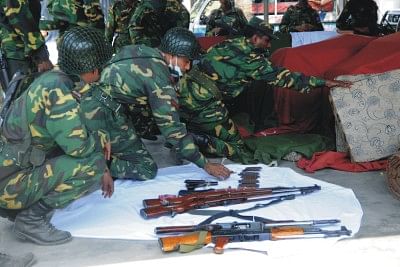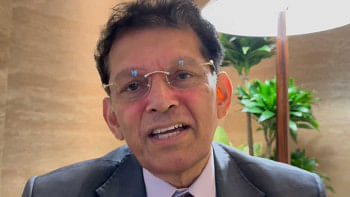Get to the roots of the mutiny

Where did it all start?Photo: AFP
WE have not quite overcome the crisis that the country was cast into on Februry 25 but have perhaps negotiated the initial period of the calamity. Much would depend on how the government and the two leading components of the country's defence the army and the BDR handle the situation at this very crucial period and in the next few weeks and months.
This is a critical time. The objective of the perpetrators was not the two defence organisations only; it was also to exploit the consequences of the political instability that they hoped would follow but, luckily for us, did not. Now that they have failed, we have to be ready for any Plan B that the enemy might have. That calls for maintaining internal stability and ensuring the rule of law.
As for the army, it is gradually emerging from the shock, although I dare say the trauma will take a long time to heal. One also hopes that the fact that the officers were able to ventilate their feelings to the prime minister very candidly has assuaged their nerves, if not totally placated their sorrow.
As for the BDR, it has been very severely affected. With so many officers killed, the command structure has been temporarily disrupted. And much as one would like to take comfort in the assurances of the new DGand we have no doubt that he and his officers and jawans are doing their utmost to protect our bordersthe fact is that this too is a traumatic experience for those troops who had nothing to do with the mutiny. It is encouraging that many of the BDR troops who fled Pilkhana are reporting back. It is important that their confidence be restored along with the restoration of the command structure.
The focus of our attention now must be to get to the roots of the massacre. The government has reconstituted, very rightly, the enquiry committee. The inquiry must be done objectively, without political interference or influence and with full assistance from all the relevant agencies of the state. However, the question is whether the committee would be able to go to the roots of the incident in the seven days that is at its disposal. There are several issues in this regard that we feel should be considered.
First, what the commission is expected to do, as I understand, is to provide at best a broad idea as to why the mutiny occurred and who were the actors behind its planning and execution, internal or external. And for that, one understands, the commission is not expected to indulge in detective work. That notwithstanding, one feels that seven days is perhaps too little for the commission, even if it works overtime, to do a worthwhile job in fulfilling its brief.
There is a great deal of information that will emerge from the statements of the witnesses as also from the available official sources, which will have to be arranged into a cogent and orderly fashion that should provide the basis for a more detailed and substantive inquiry to really get to the bottom of the matter. A half-done inquiry is of little value. The committee should be given a fortnight, if not a month, to do the minimum to justify its formation.
Secondly, the committee should at the very beginning determine the list of witnesses that it ought to hear. And that brings me to the question of its TOR which says: "The committee will look into the background ... find out reasons ... and submit recommendations."
To be able to offer a coherent recommendation in order that such incidences are prevented in future, and that our responses are sharpened in a crisis situation such as the one we faced on February 25, it is important for the commission to analyse the handling of the incident both at the political and military level, and also the sequence of command decisions and the rationale for those. And that would require taking the deposition of many high ups in the administration as well as the army. That is what one finds missing in the TOR, unless the committee takes it as implied.
Needless to say, there are some gray areas and a few unanswered questions. I refrain from going into what, to my mind, are some ambiguities in the chain of actions that were taken and, in some cases, not taken, by all, up and down the chain of civil and military command, so as not to influence the inquiry.
But certainly participation of certain persons in the negotiations with the killers has become a matter of public discussion, primarily because of the novice manner in which they played their role.
Last but not least, the findings of the committee should be made public. Its recommendations, along with that of the military committee, should be consolidated to form the basis of further and more detailed investigation into the matter.

 For all latest news, follow The Daily Star's Google News channel.
For all latest news, follow The Daily Star's Google News channel. 



Comments